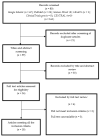Scoping Review: Evaluation of Moringa oleifera (Lam.) for Potential Wound Healing in In Vivo Studies
- PMID: 36080308
- PMCID: PMC9457785
- DOI: 10.3390/molecules27175541
Scoping Review: Evaluation of Moringa oleifera (Lam.) for Potential Wound Healing in In Vivo Studies
Abstract
Wound healing is a natural process to restore damaged tissues due to loss of tissue integrity. Moringa oleifera (locally known as merunggai in Malaysia) has been traditionally used in various ailments, including for wound management. To evaluate the wound healing properties in M. oleifera, publications were searched and selected following the guidelines of the Preferred Reporting Items for Systematic Reviews and Meta-Analyses (PRISMA) statement with predetermined inclusion criteria. The databases searched for primary studies include PubMed, Google Scholar, Science Direct, LILACS, ClinicalTrials.gov, and CENTRAL. In total, 18 in vivo studies were included, which involved the leaves, while the remaining 5 studies involved other plant parts tested on excision, incision, dead space, abrasion, and burn-induced wound models. All studies reported significant wound healing abilities. Most studies used different topical formulations of aqueous leaves extract. The accumulation of collagen content and underlying wound healing mechanism through antimicrobial, antioxidant, and anti-inflammatory activities may be contributed by its bioactive phytochemical content, which has the potential to accelerate the wound contraction, increase the rate of epithelialization, and protect tissues against oxidative damage. In conclusion, M. oleifera showed wound healing potential but further studies are warranted to determine the main bioactive phytocompounds and safety.
Keywords: Moringa oleifera; epithelialization; herbal medicine; merunggai; wound healing.
Conflict of interest statement
The authors declare no conflict of interest.
Figures



References
Publication types
MeSH terms
Substances
LinkOut - more resources
Full Text Sources

